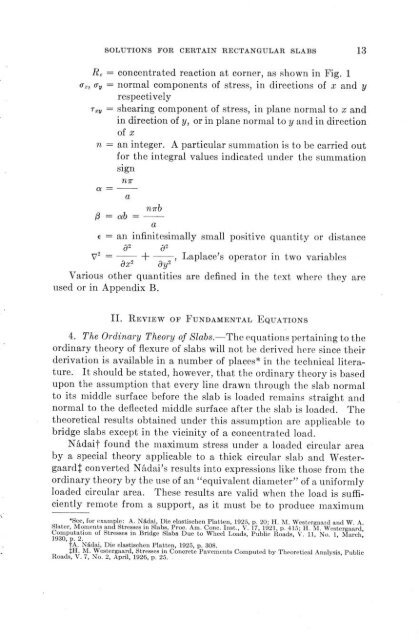Solutions for certain rectangular slabs continuous over flexible ...
Solutions for certain rectangular slabs continuous over flexible ...
Solutions for certain rectangular slabs continuous over flexible ...
You also want an ePaper? Increase the reach of your titles
YUMPU automatically turns print PDFs into web optimized ePapers that Google loves.
SOLUTIONS FOR CERTAIN RECTANGULAR<br />
SLABS<br />
Re = concentrated reaction at corner, as shown in Fig. 1<br />
or,, o- = normal components of stress, in directions of x and y<br />
respectively<br />
Txv = shearing component of stress, in plane normal to x and<br />
in direction of y, or in plane normal to y and in direction<br />
of x<br />
n = an integer. A particular summation is to be carried out<br />
<strong>for</strong> the integral values indicated under the summation<br />
sign<br />
n7r<br />
a =<br />
a<br />
nirb<br />
3 = ab = -<br />
a<br />
= an infinitesimally small positive quantity or distance<br />
)2 a 2<br />
V 2 - + - , Laplace's operator in two variables<br />
X2 a9-y 2<br />
Various other quantities are defined in the text where they are<br />
used or in Appendix B.<br />
II. REVIEW OF FUNDAMENTAL EQUATIONS<br />
4. The Ordinary Theory of Slabs.-The equations pertaining to the<br />
ordinary theory of flexure of <strong>slabs</strong> will not be derived here since their<br />
derivation is available in a number of places* in the technical literature.<br />
It should be stated, however, that the ordinary theory is based<br />
upon the assumption that every line drawn through the slab normal<br />
to its middle surface be<strong>for</strong>e the slab is loaded remains straight and<br />
normal to the deflected middle surface after the slab is loaded. The<br />
theoretical results obtained under this assumption are applicable to<br />
bridge <strong>slabs</strong> except in the vicinity of a concentrated load.<br />
NAdait found the maximum stress under a loaded circular area<br />
by a special theory applicable to a thick circular slab and Westergaardt<br />
converted NAdai's results into expressions like those from the<br />
ordinary theory by the use of an "equivalent diameter" of a uni<strong>for</strong>mly<br />
loaded circular area. These results are valid when the load is sufficiently<br />
remote from a support, as it must be to produce maximum<br />
*See, <strong>for</strong> example: A. Nadai, Die elastischen Platten, 1925, p. 20; H. M. Westergaard and W. A.<br />
Slater, Moments and Stresses in Slabs, Proc. Am. Cone. Inst., V. 17, 1921, p. 415; H. M. Westergaard,<br />
Computation of Stresses in Bridge Slabs Due to Wheel Loads, Public Roads, V. 11, No. 1, March,<br />
1930, p. 2.<br />
tA. Nadai, Die elastischen Platten, 1925, p. 308.<br />
$H. M. Westergaard, Stresses in Concrete Pavements Computed by Theoretical Analysis, Public<br />
Roads, V. 7, No. 2, April, 1926, p. 25.
















